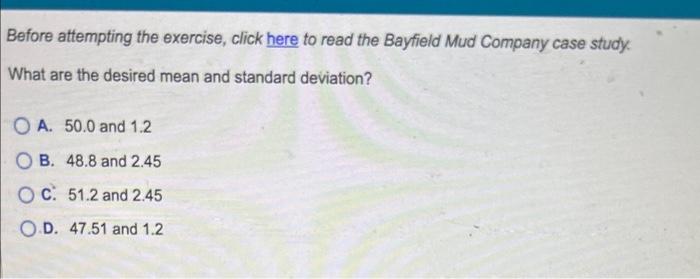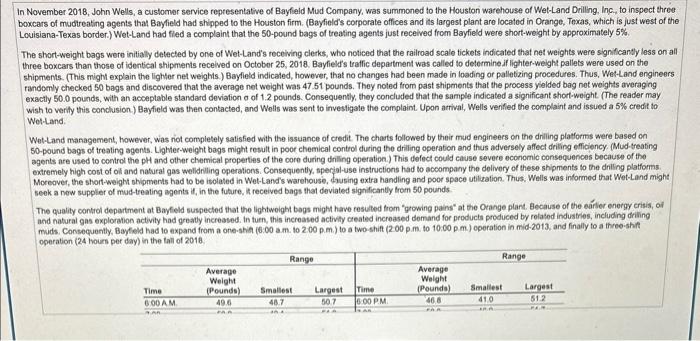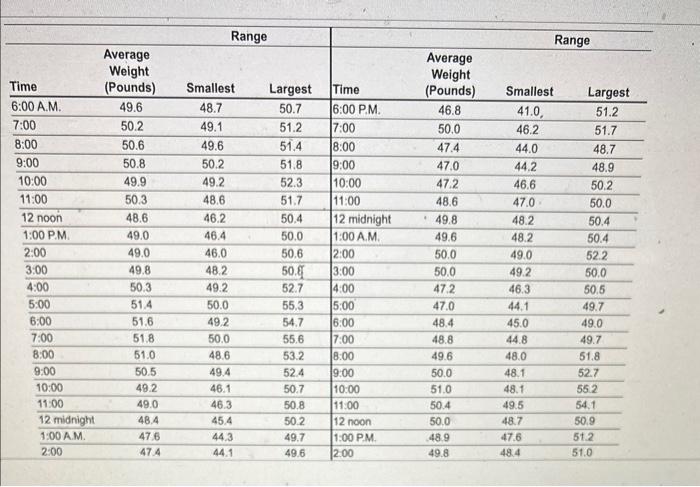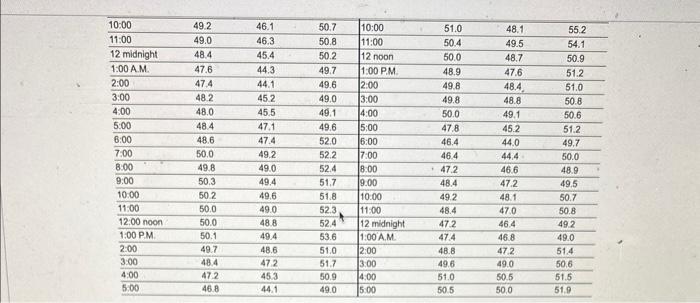Before attempting the exercise, click here to read the Bayfield Mud Company case study. What are the desired mean and standard deviation? A. 50.0 and 1.2 B. 48.8 and 2.45 C. 51.2 and 2.45 D. 47.51 and 1.2 In November 2018, John Wells, a cuslomer service representative of Bayfield Mud Company, was summoned to the Houston warehouse of Wet-Land Drilling, Inc, to inspect three boxcars of mudtrealing agents that Bayfield had shipped to the Houston firm. (Bayfield's corporate offices and its largest plant are located in Orange, Texas, which is just west of the Lovisiana-Texas border.) Wet-Land had fied a complaint that the 50 -pound bags of treating agents just received from Bayfield were short-weight by approximately 5 i., The short-weight bags were initialy detected by one of Wet-Land's receiving clerks, who noticed that the railroad scale tickets indicated that net weights were significanty less on all three boxcars than those of identical shipments recelved on October 25, 2018. Bayfield's traffic department was called to determine. if lighter-weight pallets were used on the shipments. (This might explain the lighter net weights.) Baylield indicated, howover, that no changes had been made in loading or palletizing procedures. Thus, Wet-Land engineers randemly checked 50 bags and discovered that the average net weight was 47.51 pounds. They noted from past shipments that the process yeiked bag not weights averaging exactly 50.0 pounds, with an acceptable standard deviation o of 1.2 pounds. Consequently, they concluded that the sample indicated a significant short-weight. (The reader may wish to verity this conclusion.) Baytield was then contacted, and Wells was sent to investigate the complaint. Upon arrival, Wells venified the complaint and issued a 5% credit to Wothand. Wet-Land management, however, was riot completely satisfied with the issuance of credit. The charts followed by their mud engineers on the driling plaforms were based on 50-pound bags of treating agents. Lighter-weight bags might result in poor chemical control duting the driling operation and thus adversely affect driling efficiency. (Mud-treating agents are used to controt the pH and other chemical properties of the core during dilling operation.) This defect could cause severe economic consequences because of the extremely high cost of oll and natural gas welidriling operations. Consequently, sperial-use instructions had to accompany the delivery of these shipments to the driling platforms: Moreover, the short-weight shipmeris had to be isolated in Wet-Land's warehouse, thusing extra handing and poor space utiliation. Thus. Wells was informed that Wet-Land might seek a new suppler of mud-treating agents it, in the future, i received bags that deviated signilicanily trom 50 pounds. The quality control department at Bayfield suspected that the lightwoight bogs might have resulted from "growing pans" at the Orange plart. Because of the eller energy crisis, of and natural gas exploraton actevity had greatly increased. in turn, this increased activily oreated incroased demand for products produced by related industries, including drising muds. Consequently, Bayfeld had to expand from a one.shit (6.00am. to 2.00p.m. ) to a two-shift (2.00p.m. to 10.00p.m. eperation in mid-2013, and finally to a three-sht operation (24 hours per day) in the tall of 2018 . The additional night-shift bagging crew was stafled entirely by new employees. The most experienced foremen were temporarily assigned to supervise the nigh-shif employees. Most emphasis was placed on increasing the output of bags to meet everincreasing demand. It was suspected that only occasional reminders were made to double-check the bag weight.feeder. (A double-check is performed by systematcally weighing a bag on a scale to determine if the proper weight is being loaded by the weight-feeder. If there is aignificant devation from 50 pounds, corrective adpustuntents are made to the weight-release mechanism) To verify this expectation. the qually control stafl randomly sampled the beg outout and prepared the chart on the previous page. Six bags were sampled and weighed eoch hour. Before attempting the exercise, click here to read the Bayfield Mud Company case study. What are the desired mean and standard deviation? A. 50.0 and 1.2 B. 48.8 and 2.45 C. 51.2 and 2.45 D. 47.51 and 1.2 In November 2018, John Wells, a cuslomer service representative of Bayfield Mud Company, was summoned to the Houston warehouse of Wet-Land Drilling, Inc, to inspect three boxcars of mudtrealing agents that Bayfield had shipped to the Houston firm. (Bayfield's corporate offices and its largest plant are located in Orange, Texas, which is just west of the Lovisiana-Texas border.) Wet-Land had fied a complaint that the 50 -pound bags of treating agents just received from Bayfield were short-weight by approximately 5 i., The short-weight bags were initialy detected by one of Wet-Land's receiving clerks, who noticed that the railroad scale tickets indicated that net weights were significanty less on all three boxcars than those of identical shipments recelved on October 25, 2018. Bayfield's traffic department was called to determine. if lighter-weight pallets were used on the shipments. (This might explain the lighter net weights.) Baylield indicated, howover, that no changes had been made in loading or palletizing procedures. Thus, Wet-Land engineers randemly checked 50 bags and discovered that the average net weight was 47.51 pounds. They noted from past shipments that the process yeiked bag not weights averaging exactly 50.0 pounds, with an acceptable standard deviation o of 1.2 pounds. Consequently, they concluded that the sample indicated a significant short-weight. (The reader may wish to verity this conclusion.) Baytield was then contacted, and Wells was sent to investigate the complaint. Upon arrival, Wells venified the complaint and issued a 5% credit to Wothand. Wet-Land management, however, was riot completely satisfied with the issuance of credit. The charts followed by their mud engineers on the driling plaforms were based on 50-pound bags of treating agents. Lighter-weight bags might result in poor chemical control duting the driling operation and thus adversely affect driling efficiency. (Mud-treating agents are used to controt the pH and other chemical properties of the core during dilling operation.) This defect could cause severe economic consequences because of the extremely high cost of oll and natural gas welidriling operations. Consequently, sperial-use instructions had to accompany the delivery of these shipments to the driling platforms: Moreover, the short-weight shipmeris had to be isolated in Wet-Land's warehouse, thusing extra handing and poor space utiliation. Thus. Wells was informed that Wet-Land might seek a new suppler of mud-treating agents it, in the future, i received bags that deviated signilicanily trom 50 pounds. The quality control department at Bayfield suspected that the lightwoight bogs might have resulted from "growing pans" at the Orange plart. Because of the eller energy crisis, of and natural gas exploraton actevity had greatly increased. in turn, this increased activily oreated incroased demand for products produced by related industries, including drising muds. Consequently, Bayfeld had to expand from a one.shit (6.00am. to 2.00p.m. ) to a two-shift (2.00p.m. to 10.00p.m. eperation in mid-2013, and finally to a three-sht operation (24 hours per day) in the tall of 2018 . The additional night-shift bagging crew was stafled entirely by new employees. The most experienced foremen were temporarily assigned to supervise the nigh-shif employees. Most emphasis was placed on increasing the output of bags to meet everincreasing demand. It was suspected that only occasional reminders were made to double-check the bag weight.feeder. (A double-check is performed by systematcally weighing a bag on a scale to determine if the proper weight is being loaded by the weight-feeder. If there is aignificant devation from 50 pounds, corrective adpustuntents are made to the weight-release mechanism) To verify this expectation. the qually control stafl randomly sampled the beg outout and prepared the chart on the previous page. Six bags were sampled and weighed eoch hour











